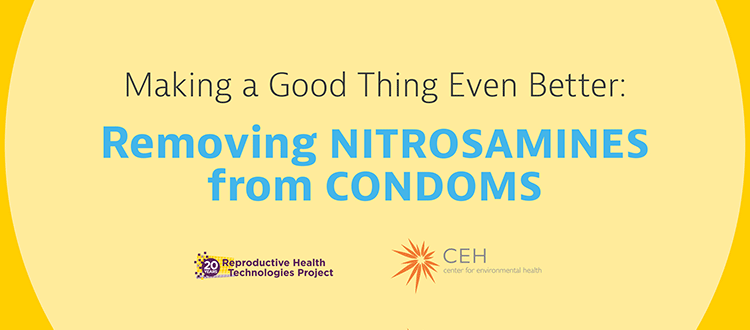Greening Condoms: Making a Good Thing Better
 |
|
Jessica Arons Reproductive Health |
 |
|
Caroline Cox Center for Environmental |
Whether it’s “greening” our cars or our dry cleaning, it’s now quite common for Americans to seek out products that have a minimal impact on the environment and our health. What’s much less common is any discussion about green contraception – in other words, contraception that leaves as small a footprint as possible and minimizes our exposure to needless and potentially harmful chemicals.
Condoms are an essential tool in protecting people’s sexual and reproductive health. But in 2010, the World Health Organization (WHO) and the United Nations Population Fund (UNFPA) recommended that manufacturers minimize the presence of nitrosamines, a class of carcinogenic chemicals, in male latex condoms. Exposure to nitrosamines from condoms is quite low relative to other sources of exposure, but their presence in condoms is unnecessary and can be readily removed. Thus, they should be.
Nitrosamines are found in a wide variety of rubber products including balloons, gloves, baby bottle nipples, and pacifiers, as well as in some processed meats such as hot dogs and cooked bacon, some types of cheese, drinking water, and tobacco smoke. To put things in perspective, we estimate that the level of nitrosamines in our daily intake of food is at least five times higher than the average exposure to nitrosamines from using a condom one time. But it is exactly because of this cumulative exposure to nitrosamines throughout our lives that it is important to eliminate exposures to the substance wherever possible.
It is with that goal in mind that the Reproductive Health Technologies Project (RHTP) and the Center for Environmental Health (CEH) commissioned testing to get a sense of the state of play in the U.S. condom market following the WHO and UNFPA recommendation. We obtained samples of 24 different condoms in December 2013 and sent them for testing in February 2014 to determine the amount of nitrosamines that would be released from each condom during typical use.
What we learned was encouraging. Of the condoms we tested, almost one-third did not release any detectable levels of nitrosamines, including some well-known brands with large market shares. Approximately another third released levels that fall below a regulatory standard for certain rubber toys set by the European Union.
The remaining third did exceed the EU threshold, but of those, the makers of half have already indicated to RHTP that they are aware of the issue and taking steps to monitor and reduce the levels of nitrosamines in their products.
The takeaways: the proven benefits of condoms in terms of HIV/AIDS, sexually transmitted infection, and pregnancy prevention far outweigh any possible health risks posed by exposure to nitrosamines from some condoms; nitrosamines should be removed from condoms because they can be; and the condom industry has already made substantial progress in making condoms with undetectable levels of nitrosamines the new industry norm.
We applaud the actions of those who have proactively sought to ensure that their products are as safe as possible and who have followed the precautionary principle of reducing consumer exposure to potentially harmful substances. And we look forward to the possibility that within the next six months, the makers of all of the products we tested that released nitrosamines will have pledged to eliminate detectable levels of nitrosamines from their products and taken concrete steps to fulfill that pledge.
Men and women can continue to rely on condoms to protect their sexual and reproductive health. But now, with this trend to eliminate nitrosamines from condoms, we know the health benefits of condoms are getting even better.
Check out the report to see which condoms didn’t release nitrosamines.



